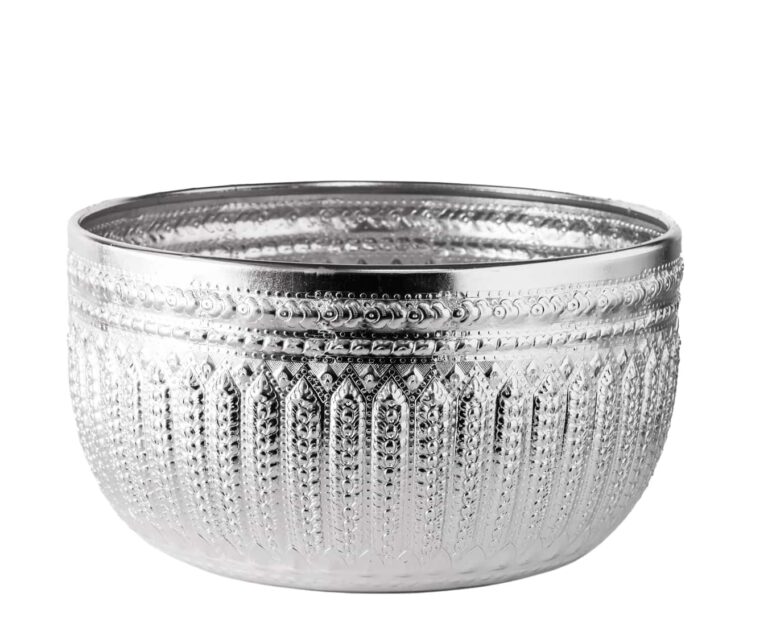
Silver bowls

History of silver bowls
The story of silver bowls began in the cradle of civilization, where ancient cultures discovered the malleability and beauty of silver. Mesopotamia, around 3000 BCE, witnessed the emergence of silver bowls as both utilitarian vessels and expressions of wealth. Beyond their functional use, these bowls became status symbols, reflecting the social standing of their owners.
In ancient Egypt, silver bowls adorned the tables of pharaohs and nobility. Crafted with meticulous detail, these vessels often bore engravings depicting scenes of daily life, religious symbolism, and hieroglyphs. Silver, with its lustrous surface, was revered for its aesthetic appeal and its purported antibacterial properties, adding a layer of mystique to these ancient artifacts.
The classical civilizations of Greece and Rome elevated the artistry associated with silver bowls. In ancient Greece, these vessels became integral to the lavish feasts where the elite celebrated culture, philosophy, and camaraderie. Silver bowls were not merely functional; they were canvases for intricate designs, showcasing the skill of artisans. The reflective surfaces of these bowls mirrored the intellectual and artistic achievements of the time.
The Roman Empire continued this tradition, with silver bowls playing a prominent role in both daily life and grand banquets. Wealthy Romans flaunted their affluence by commissioning extravagant silverware adorned with gemstones, contributing to the opulence of Roman society. Silver bowls became statements of prestige and refinement, reflecting the sophistication of classical civilization.
As Europe transitioned into the medieval period, silver bowls took on new forms and acquired additional layers of significance. The use of silver bowls in Churches became widespread as part of ceremonies and rituals.
The Renaissance era witnessed a revival of interest in classical art and culture, influencing the design and craftsmanship of silverware. Artisans employed intricate filigree work, embossing, and chasing techniques to create exquisite pieces that mirrored the artistic spirit of the time.
During the 15th and 16th centuries, The Age of Exploration marked a significant chapter in the history of silver bowls. The exploration of the Americas led to the discovery of vast silver deposits, particularly in regions like Potosí in present-day Bolivia. The influx of silver into Europe and Asia had profound implications for the crafting of silverware.
The interconnectedness of global trade routes during the 17th and 18th centuries facilitated the exchange of silver bowls between East and West. Asian silver bowls, particularly those from China and India, found their way to European markets, influencing Western design sensibilities. The delicate craftsmanship of Asian silver bowls, often featuring intricate engravings and repoussé work, captivated collectors and connoisseurs alike.
Colonial America also played a significant role in the history of silver bowls. Silversmiths in the American colonies, influenced by European styles, produced unique pieces that reflected the evolving tastes of the New World. These artisans blended traditional craftsmanship with emerging design trends, creating silver bowls that spoke to the cultural fusion characteristic of colonial America.
The Industrial Revolution and mass production of silver bowls
The 19th century brought about the Industrial Revolution, transforming the landscape of silverware production. Mass production techniques allowed for the creation of more affordable silver bowls, making them accessible to a broader spectrum of society. While traditional craftsmanship persisted, the era marked a shift towards machine-made silverware, democratizing the ownership of these once-exclusive items.
Artistic Movements of the 20th Century.
In the 20th and 21st centuries, silver bowls continue to be celebrated as symbols of refined taste and sophistication. While mass production remains prevalent, there has been a resurgence of interest in handmade and artisanal silverware. Modern silversmiths draw inspiration from historical designs while incorporating contemporary elements, creating a fusion of tradition and innovation.
Silver bowls with their glittering surfaces and elaborate decorations, encourage us to contemplate the enduring history of human creativity and the pursuit of beauty that has stood the test of time. The history of silver bowls, with all of its twists and turns, is still unfolding, and it invites us to admire the artistry and stories that are embedded in each sparkling cup.
Preserving and conserving
Most silver brokers purchase silver and silver plate items intending to sell them as scrap to be melted down. I approach things differently at the Man of Silver. Items that have inherent value due to the manufacturer or the craftsmanship in their design, in my opinion, when possible, should be preserved and conserved. The Man of Silver makes every effort to locate a new home for silver pieces that may no longer suit your tastes but rather someone else’s. I have a booth and two showcases at a local antique mall and have sold thousands of pieces of jewelry and over 200 flatware sets.
Sell your silver bowls
The Man of Silver will buy your Sterling Silver and silver plate bowls, Sterling Silver and silver plate flatware, Sterling Silver Jewelry in any condition, Sterling Silver and silver plate tea sets and trays, gold jewelry, luxury watches, silver coins, Sterling Silver and silver plate candlesticks and candelabras, costume jewelry and fashion jewelry.
Sell your silver bowls and more in Chicagoland.
Every day I work with clients in the comfort of their homes, offices, or banks in the counties of Cook, Lake, Kane, McHenry, and DuPage. I also see clients in my office in Lincolnwood, Illinois. The Man of Silver has a family tradition in the Chicago area of serving customer’s needs. My family has helped tens of thousands of happy customers over the past 60 years. I am committed to giving my customers the best price on the silver or silver-plated pieces that they are selling based on the live price. Place your trust in a local company with roots in Chicagoland.
Call or text today to arrange your no obligation appointment.
- Phone or text 847-668-5442

